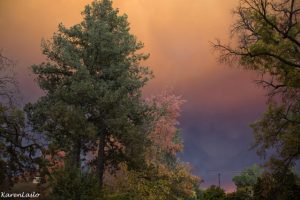
First day of Camp Fire
At Chico’s Walmart parking lot, you see the new homeless: Several hundred people, some living out of RVs, some out of cars, some out of tents, some with nothing more than a few blankets. This is what a community borne of disaster looks like: Food vendors who want to give, not sell. Guitar-strumming teenagers, scientologists, massage chairs and chaplains.
This is where many displaced people who were already living on the edge – of canyons, of finances, of California’s blue political culture –lodged when the Camp Fire swept through their communities, and here as elsewhere, disaster response has been underway. Chicoans pull in with boxed donations and trailers hauled from other cities deposit piles of used clothing and worn shoes.
